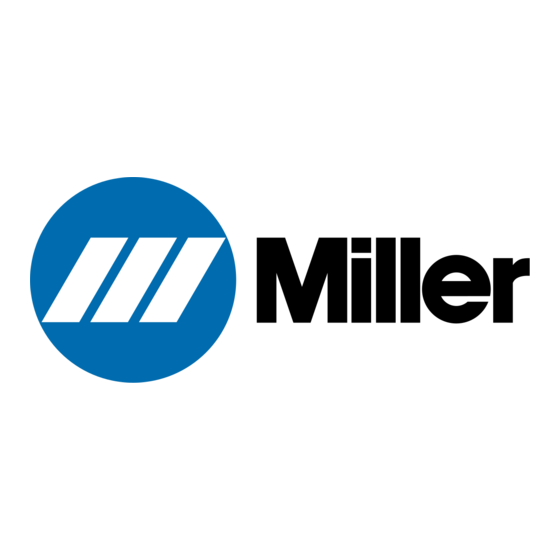Miller XMT 400 CC Instrukcja obsługi - Strona 6
Przeglądaj online lub pobierz pdf Instrukcja obsługi dla System spawania Miller XMT 400 CC. Miller XMT 400 CC 40 stron.

WELDING
can cause
fire
or
explosion.
Welding
on
closed
containers,
such
as
tanks, drums,
or
pipes,
can
cause
them to blow up.
Sparks
can
fly
off from the
welding
arc.
The
flying sparks,
hot
workpiece,
and hot
equipment
can
cause
fires and
burns. Accidental contact of electrode
to
metal
objects
can cause
sparks, explosion, overheating,
or
fire. Check and be
sure
the
area
is safe before
doing
any
welding.
1.
Protect
yourself
and others from
flying sparks
and hot metal.
2.
Do
not
weld where
flying sparks
can
strike
flammable
material.
3.
Remove all flammables within 35 ft
(10.7 m)
of the
welding
arc.
If
this is not
possible, tightly
cover
them with
approved
covers.
4.
Be alert that
welding
sparks
and hot materials from
welding
can
easily
go
through
small cracks and
openings
to
adjacent
areas.
5.
Watch for
fire,
and
keep
a
fire
extinguisher nearby.
6.
Be
aware
that
welding
on a
ceiling,
floor, bulkhead,
or
partition
can
cause
fire
on
the hidden side.
7.
Do
not weld
on
closed containers such
as
tanks, drums,
or
pipes,
unless
they
are
properly prepared according
to
AWS F4.
1
(see Safety Standards).
8.
Connect work cable
to
the work
as
close to the
welding
area as
practical
to
prevent
welding
current from
traveling long, possibly
unknown
paths
and
causing
electric
shock and fire hazards.
9.
Do
not
use
welder
to thaw
frozen
pipes.
10.
Remove stick electrode from holder
or
cut
off
welding
wire
at
contact
tip
when
not in
use.
11.
Wear oil-free
protective
garments
such
as
leather
gloves, heavy
shirt,
cuffless trousers,
high
shoes,
and
a
cap.
12.
Remove any
combustibles,
such
as
a
butane
lighter
or
matches,
from your person before
doing
any
welding.
ENGINE
FUEL
can
cause
fire
or
explosion.
Engine
fuel is
highly
flammable.
1.
Stop engine
and let it cool off
before
checking
or
adding
fuel.
2.
Do
not
add fuel while
smoking
or
if unit is
near
any
sparks
or
MOVING PARTS
can cause
injury.
Moving
parts,
such
as
fans,
rotors, and
belts
can
cut
fingers
and hands and catch loose
clothing.
1.
Keep
all
doors,
panels,
covers,
and
guards
closed and
securely
in
place.
2.
Stoo
engine
before
installing
or
connecting
unit
SPARKS
can cause
BATTERY GASES
TO
EXPLODE;
BATTERY
ACID
can
burn eyes and skin.
Batteries contain acid and
generate
explosive
gases.
3.
Have
only
qualified
people
remove
guards
or
covers
for
maintenance and
troubleshooting
as
necessary.
4.
To
prevent
accidental
starting during servicing,
disconnect
negative () battery
cable from
battery.
5.
Keep
hands, hair,
loose
clothing,
and tools away from
moving
parts.
6.
Reinstall
panels
or
guards
and close doors when
servicing
is
finished and before
starting engine.
Always
wear a
face shield when
working
on
a
battery.
Stop engine
before
disconnecting
or
connecting
battery
cables.
3.
Do
not
allow tools
to
cause
sparks
when
working
on
a
battery.
Do
not
use
welder
to
charge
batteries
or
jump
start
vehicles.
PRINCIPAL SAFETY STANDARDS
Safety
in
Welding
and
Cutting,
ANSI Standard Z49.
1,
from American
Welding Society,
550 N.W. LeJeune
Rd,
Miami
FL 33126
Safety
and Health
Standards,
OSHA
29
CFR
1910,
from
Superinten
dent of
Documents,
U.S. Government
Printing
Office,
Washington,
D.C. 20402.
Recommended Safe Practices for the
Preparafion
for
Welding
and
Cutting
of Containers That Have Held Hazardous
Substances,
Ameri
can
Welding Society
Standard AWS
F4.i,from
American
Welding
So
ciety,
550 N.W. LeJeune
Rd, Miami,
FL 33126
National Electrical
Code,
NFPA Standard
70,
from National Fire Pro
tection
Association,
Batterymarch
Park,
Quincy,
MA 02269.
Safe
Handling
of
Compressed
Gases
in
Cylinders,
CGA
Pamphlet
P-i,
from
Compressed
Gas
Association,
1235 Jefferson Davis
High
way, Suite
501,
Arlington,
VA 22202.
Code for
Safety
in
Welding
and
Cutting,
GSA Standard Wi
17.2,
from
Canadian Standards
Association,
Standards
Sales,
178
Rexdale
Bou
levard,
Rexdate. Ontario, Canada
M9W
1
R3.
Safe Practices For
Occupation
And Educational
Eye
And Face Protec
tion,
ANSI Standard Z87.
1,
from American National Standards
Institute,
1430
Broadway,
New
York,
NY 10018.
Cutting
And
Welding
Processes,
NFPA Standard 51
B,
from National
Fire Protection
Association,
Batterymarch
Park,
Qilincy,
MA 02269.
a
WARNING
ENGINE EXHAUST GASES
can
kill.
1.
Use
equipment
outside in open, well-ventilated
areas.
ENGINES
can
be hazardous.
Engines
produce
harmful exhaust gases.
2.
If used in
a
closed
area, vent
engine
exhaust outside and
away
from any
building
air intakes.
3.
Do
not
overfill tank
allow
room
for fuel
to
expand.
4.
Do not
spill
fuel. If fuel is
spilled,
clean up before
starting
engine.
1.
2.
4.
5.
Observe
correct
polarity (
and
)
on
batteries.
STEAM
AND
PRESSURIZED
HOT
1.
If the
engine
is
warm
and
checking
is
needed,
follow
steps
2
COOLANT
can
skin.
burn
face,
eyes,
and
2.
and 3.
Wear
safety glasses
and
gloves
and
put
a
rag
over
cap.
It is best to check coolant level when
engine
is cold
to avoid
scalding.
3.
Turn cap
slightly
and let pressure escape
slowly
before
completely removing
cap.
srl.1.1 2/94
